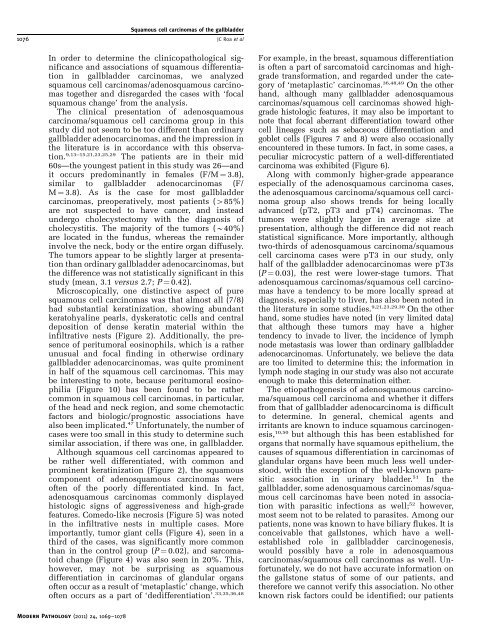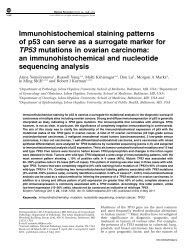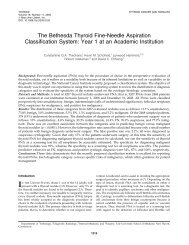Squamous cell and adenosquamous carcinomas of ... - BPA Pathology
Squamous cell and adenosquamous carcinomas of ... - BPA Pathology
Squamous cell and adenosquamous carcinomas of ... - BPA Pathology
You also want an ePaper? Increase the reach of your titles
YUMPU automatically turns print PDFs into web optimized ePapers that Google loves.
<strong>Squamous</strong> <strong>cell</strong> <strong>carcinomas</strong> <strong>of</strong> the gallbladder<br />
1076 JC Roa et al<br />
In order to determine the clinicopathological significance<br />
<strong>and</strong> associations <strong>of</strong> squamous differentiation<br />
in gallbladder <strong>carcinomas</strong>, we analyzed<br />
squamous <strong>cell</strong> <strong>carcinomas</strong>/<strong>adenosquamous</strong> <strong>carcinomas</strong><br />
together <strong>and</strong> disregarded the cases with ‘focal<br />
squamous change’ from the analysis.<br />
The clinical presentation <strong>of</strong> <strong>adenosquamous</strong><br />
carcinoma/squamous <strong>cell</strong> carcinoma group in this<br />
study did not seem to be too different than ordinary<br />
gallbladder adeno<strong>carcinomas</strong>, <strong>and</strong> the impression in<br />
the literature is in accordance with this observation.<br />
9,13–15,21,23,25,29 The patients are in their mid<br />
60s—the youngest patient in this study was 26—<strong>and</strong><br />
it occurs predominantly in females (F/M ¼ 3.8),<br />
similar to gallbladder adeno<strong>carcinomas</strong> (F/<br />
M ¼ 3.8). As is the case for most gallbladder<br />
<strong>carcinomas</strong>, preoperatively, most patients (485%)<br />
are not suspected to have cancer, <strong>and</strong> instead<br />
undergo cholecystectomy with the diagnosis <strong>of</strong><br />
cholecystitis. The majority <strong>of</strong> the tumors (B40%)<br />
are located in the fundus, whereas the remainder<br />
involve the neck, body or the entire organ diffusely.<br />
The tumors appear to be slightly larger at presentation<br />
than ordinary gallbladder adeno<strong>carcinomas</strong>, but<br />
the difference was not statistically significant in this<br />
study (mean, 3.1 versus 2.7; P ¼ 0.42).<br />
Microscopically, one distinctive aspect <strong>of</strong> pure<br />
squamous <strong>cell</strong> <strong>carcinomas</strong> was that almost all (7/8)<br />
had substantial keratinization, showing abundant<br />
keratohyaline pearls, dyskeratotic <strong>cell</strong>s <strong>and</strong> central<br />
deposition <strong>of</strong> dense keratin material within the<br />
infiltrative nests (Figure 2). Additionally, the presence<br />
<strong>of</strong> peritumoral eosinophils, which is a rather<br />
unusual <strong>and</strong> focal finding in otherwise ordinary<br />
gallbladder adeno<strong>carcinomas</strong>, was quite prominent<br />
in half <strong>of</strong> the squamous <strong>cell</strong> <strong>carcinomas</strong>. This may<br />
be interesting to note, because peritumoral eosinophilia<br />
(Figure 10) has been found to be rather<br />
common in squamous <strong>cell</strong> <strong>carcinomas</strong>, in particular,<br />
<strong>of</strong> the head <strong>and</strong> neck region, <strong>and</strong> some chemotactic<br />
factors <strong>and</strong> biologic/prognostic associations have<br />
also been implicated. 47 Unfortunately, the number <strong>of</strong><br />
cases were too small in this study to determine such<br />
similar association, if there was one, in gallbladder.<br />
Although squamous <strong>cell</strong> <strong>carcinomas</strong> appeared to<br />
be rather well differentiated, with common <strong>and</strong><br />
prominent keratinization (Figure 2), the squamous<br />
component <strong>of</strong> <strong>adenosquamous</strong> <strong>carcinomas</strong> were<br />
<strong>of</strong>ten <strong>of</strong> the poorly differentiated kind. In fact,<br />
<strong>adenosquamous</strong> <strong>carcinomas</strong> commonly displayed<br />
histologic signs <strong>of</strong> aggressiveness <strong>and</strong> high-grade<br />
features. Comedo-like necrosis (Figure 5) was noted<br />
in the infiltrative nests in multiple cases. More<br />
importantly, tumor giant <strong>cell</strong>s (Figure 4), seen in a<br />
third <strong>of</strong> the cases, was significantly more common<br />
than in the control group (P ¼ 0.02), <strong>and</strong> sarcomatoid<br />
change (Figure 4) was also seen in 20%. This,<br />
however, may not be surprising as squamous<br />
differentiation in <strong>carcinomas</strong> <strong>of</strong> gl<strong>and</strong>ular organs<br />
<strong>of</strong>ten occur as a result <strong>of</strong> ‘metaplastic’ change, which<br />
<strong>of</strong>ten occurs as a part <strong>of</strong> ‘dedifferentiation’. 33,35,36,48<br />
For example, in the breast, squamous differentiation<br />
is <strong>of</strong>ten a part <strong>of</strong> sarcomatoid <strong>carcinomas</strong> <strong>and</strong> highgrade<br />
transformation, <strong>and</strong> regarded under the category<br />
<strong>of</strong> ‘metaplastic’ <strong>carcinomas</strong>. 36,48,49 On the other<br />
h<strong>and</strong>, although many gallbladder <strong>adenosquamous</strong><br />
<strong>carcinomas</strong>/squamous <strong>cell</strong> <strong>carcinomas</strong> showed highgrade<br />
histologic features, it may also be important to<br />
note that focal aberrant differentiation toward other<br />
<strong>cell</strong> lineages such as sebaceous differentiation <strong>and</strong><br />
goblet <strong>cell</strong>s (Figures 7 <strong>and</strong> 8) were also occasionally<br />
encounteredinthesetumors.Infact,insomecases,a<br />
peculiar microcystic pattern <strong>of</strong> a well-differentiated<br />
carcinoma was exhibited (Figure 6).<br />
Along with commonly higher-grade appearance<br />
especially <strong>of</strong> the <strong>adenosquamous</strong> carcinoma cases,<br />
the <strong>adenosquamous</strong> carcinoma/squamous <strong>cell</strong> carcinoma<br />
group also shows trends for being locally<br />
advanced (pT2, pT3 <strong>and</strong> pT4) <strong>carcinomas</strong>. The<br />
tumors were slightly larger in average size at<br />
presentation, although the difference did not reach<br />
statistical significance. More importantly, although<br />
two-thirds <strong>of</strong> <strong>adenosquamous</strong> carcinoma/squamous<br />
<strong>cell</strong> carcinoma cases were pT3 in our study, only<br />
half <strong>of</strong> the gallbladder adeno<strong>carcinomas</strong> were pT3s<br />
(P ¼ 0.03), the rest were lower-stage tumors. That<br />
<strong>adenosquamous</strong> <strong>carcinomas</strong>/squamous <strong>cell</strong> <strong>carcinomas</strong><br />
have a tendency to be more locally spread at<br />
diagnosis, especially to liver, has also been noted in<br />
the literature in some studies. 9,21,23,29,30 On the other<br />
h<strong>and</strong>, some studies have noted (in very limited data)<br />
that although these tumors may have a higher<br />
tendency to invade to liver, the incidence <strong>of</strong> lymph<br />
node metastasis was lower than ordinary gallbladder<br />
adeno<strong>carcinomas</strong>. Unfortunately, we believe the data<br />
are too limited to determine this; the information in<br />
lymph node staging in our study was also not accurate<br />
enough to make this determination either.<br />
The etiopathogenesis <strong>of</strong> <strong>adenosquamous</strong> carcinoma/squamous<br />
<strong>cell</strong> carcinoma <strong>and</strong> whether it differs<br />
from that <strong>of</strong> gallbladder adenocarcinoma is difficult<br />
to determine. In general, chemical agents <strong>and</strong><br />
irritants are known to induce squamous carcinogenesis,<br />
10,50 but although this has been established for<br />
organs that normally have squamous epithelium, the<br />
causes <strong>of</strong> squamous differentiation in <strong>carcinomas</strong> <strong>of</strong><br />
gl<strong>and</strong>ular organs have been much less well understood,<br />
with the exception <strong>of</strong> the well-known parasitic<br />
association in urinary bladder. 51 In the<br />
gallbladder, some <strong>adenosquamous</strong> <strong>carcinomas</strong>/squamous<br />
<strong>cell</strong> <strong>carcinomas</strong> have been noted in association<br />
with parasitic infections as well; 52 however,<br />
most seem not to be related to parasites. Among our<br />
patients, none was known to have biliary flukes. It is<br />
conceivable that gallstones, which have a wellestablished<br />
role in gallbladder carcinogenesis,<br />
would possibly have a role in <strong>adenosquamous</strong><br />
<strong>carcinomas</strong>/squamous <strong>cell</strong> <strong>carcinomas</strong> as well. Unfortunately,<br />
we do not have accurate information on<br />
the gallstone status <strong>of</strong> some <strong>of</strong> our patients, <strong>and</strong><br />
therefore we cannot verify this association. No other<br />
known risk factors could be identified; our patients<br />
Modern <strong>Pathology</strong> (2011) 24, 1069–1078
















